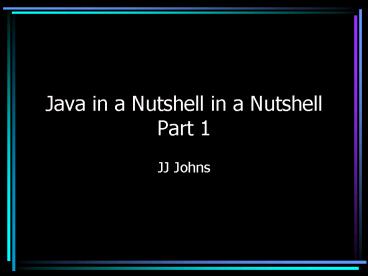Java in a Nutshell in a Nutshell Part 1 - PowerPoint PPT Presentation
1 / 14
Title:
Java in a Nutshell in a Nutshell Part 1
Description:
All Java classes go in .java files. This is a rule, not a convention. There is 1 top level public class per file ... ( Garbage collection, GUIs, etc ... – PowerPoint PPT presentation
Number of Views:108
Avg rating:3.0/5.0
Title: Java in a Nutshell in a Nutshell Part 1
1
Java in a Nutshell in a NutshellPart 1
- JJ Johns
2
Java in a Nutshell in a Nutshell
- Structure of a Java program
- Classes
- Advance Syntax
3
Structure of a Java program
- All Java classes go in .java files
- This is a rule, not a convention
- There is 1 top level public class per file
- There is no program or function outside of a
class, e.g. no main function kinda - Examples .
4
Points of Interest
- public static void main(String args)
- System.out.println()
- Primative data types work similarly, but bool is
not int - Command line java full_classname
5
Behind the Scenes in the OS
- The Java runtime environment or SDK is installed.
- The java_home/bin directory is in your PATH
- If you are using any classes outside the java or
javax package, their locations are included in
your CLASSPATH
6
Behind the Scenes in Java
- The Java Interpreter starts up and creates a new
VM. - The VM begins verifying and interpreting classes.
- The VM starts executing the users Class with its
main method.
7
Classes
- Variables and Functions are called Fields and
Methods - Instance vs. Class methods and Fields
- No this in static methods
- No more destructors, but there is finialize()
- No more const, but there is static final
- Public, Private, Protected, Package
8
Inheritance
- extends keyword
- Each class can extend only 1 class.
- Superclass constructor will always be called,
implicitly matching all parameters or 0
parameter. - Super() and super.
9
Multiple (kinda) Inheritance
- Interface A class with no instance fields and
only abstract methods. (Example) - Effectively an abstract base class
- Can contain static constants
- Keyword implements
- You can cast a class to an interface that it
implements, thereby gaining multiple inheritance,
without the hassles.
10
Inner classes
- You can define a class inside of another class.
- There are 4 ways to do this Static, Member,
Local, and Anonymous - Theyre pretty self explanatory by name, and only
useful in particular circumstances.
11
Advance Syntax
- Packages
- java.io, java.util, java
- No overloaded operators
- .equals(Object o)versus
- java.lang.Comparator Interface
12
Exceptions
- Java provides an elegant framework to handle
program errors - java.lang.Exception versus Error
- Exceptions are thrown by methods when they reach
a state that they cannot continue from. - Examples
13
synchronized
- The Java platform is threaded to the core.
(Garbage collection, GUIs, etc ) - Code that needs to be protect from having
multiple threads access at a time uses
synchronized on methods or code blocks - More to come on that.
14
The End
- As always, the best way to get comfortable with
anything is to use it. - Use what Java gives you!































